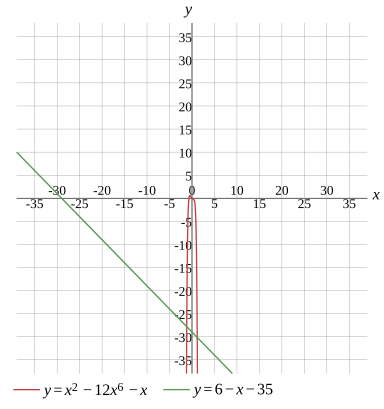Question
Solve the equation
x1≈−1.167328,x2≈1.167328
Evaluate
x2−12x6−x=6−x−35
Cancel equal terms on both sides of the expression
x2−12x6=6−35
Subtract the numbers
x2−12x6=−29
Move the expression to the left side
x2−12x6−(−29)=0
If a negative sign or a subtraction symbol appears outside parentheses, remove the parentheses and change the sign of every term within the parentheses
x2−12x6+29=0
Solve the equation using substitution t=x2
t−12t3+29=0
Calculate
t≈1.362656t≈−0.681328+1.144242it≈−0.681328−1.144242i
Substitute back
x2≈1.362656x2≈−0.681328+1.144242ix2≈−0.681328−1.144242i
Solve the equation for x
More Steps


Substitute back
x2≈1.362656
Take the root of both sides of the equation and remember to use both positive and negative roots
x=±1.362656
Simplify the expression
x=±1.167328
Separate the equation into 2 possible cases
x≈1.167328x≈−1.167328
x≈1.167328x≈−1.167328x2≈−0.681328+1.144242ix2≈−0.681328−1.144242i
Solve the equation for x
More Steps


Substitute back
x2≈−0.681328+1.144242i
Simplify
x=−0.681328+1.144242i
Rewrite the complex number in polar form
More Steps


Evaluate
−0.681328+1.144242i
Determine the modulus and the argument of the complex number
r=(−0.681328)2+1.1442422θ=arctan(−0.6813281.144242)
Calculate
r≈1.331727θ=arctan(−0.6813281.144242)
Since −0.681328+1.144242i lies in the II quadrant, add π to get the argument in the II quadrant
r≈1.331727θ=arctan(−0.6813281.144242)+π
Simplify
r≈1.331727θ=arctan(−1.679429)+π
Substitute the given values into the formula r(cosθ+isinθ)
1.331727(cos(arctan(−1.679429)+π)+isin(arctan(−1.679429)+π))
x=1.331727(cos(arctan(−1.679429)+π)+isin(arctan(−1.679429)+π))
Calculate the nth roots of a complex r(cos(θ)+i×sin(θ),using nz=nr(cosnθ+2kπ+isinnθ+2kπ)
x=1.331727×(cos(2arctan(−1.679429)+π+2kπ)+isin(2arctan(−1.679429)+π+2kπ))
Simplify
x=1.154005(cos(2arctan(−1.679429)+π+2kπ)+isin(2arctan(−1.679429)+π+2kπ))
Since n=2,substitute k=0,1 into the expression
x1=1.154005(cos(2arctan(−1.679429)+π+2×0×π)+isin(2arctan(−1.679429)+π+2×0×π))x2=1.154005(cos(2arctan(−1.679429)+π+2×1×π)+isin(2arctan(−1.679429)+π+2×1×π))
Calculate
More Steps


Evaluate
2arctan(−1.679429)+π+2×0×π
Any expression multiplied by 0 equals 0
2arctan(−1.679429)+π+0
Removing 0 doesn't change the value,so remove it from the expression
2arctan(−1.679429)+π
x1=1.154005(cos(2arctan(−1.679429)+π)+isin(2arctan(−1.679429)+π))x2=1.154005(cos(2arctan(−1.679429)+π+2×1×π)+isin(2arctan(−1.679429)+π+2×1×π))
Calculate
x1=1.154005(cos(2arctan(−1.679429)+π)+isin(2arctan(−1.679429)+π))x2=1.154005(cos(2arctan(−1.679429)+π+2π)+isin(2arctan(−1.679429)+π+2π))
Calculate
x1≈0.570263+1.003258ix2≈−0.570263−1.003258i
x≈1.167328x≈−1.167328x1≈0.570263+1.003258ix2≈−0.570263−1.003258ix2≈−0.681328−1.144242i
Solve the equation for x
More Steps


Substitute back
x2≈−0.681328−1.144242i
Simplify
x=−0.681328−1.144242i
Rewrite the complex number in polar form
More Steps


Evaluate
−0.681328−1.144242i
Determine the modulus and the argument of the complex number
r=(−0.681328)2+(−1.144242)2θ=arctan(−0.681328−1.144242)
Calculate
r≈1.331727θ=arctan(−0.681328−1.144242)
Since −0.681328−1.144242i lies in the III quadrant, add π to get the argument in the III quadrant
r≈1.331727θ=arctan(0.6813281.144242)+π
Simplify
r≈1.331727θ=arctan(1.679429)+π
Substitute the given values into the formula r(cosθ+isinθ)
1.331727(cos(arctan(1.679429)+π)+isin(arctan(1.679429)+π))
x=1.331727(cos(arctan(1.679429)+π)+isin(arctan(1.679429)+π))
Calculate the nth roots of a complex r(cos(θ)+i×sin(θ),using nz=nr(cosnθ+2kπ+isinnθ+2kπ)
x=1.331727×(cos(2arctan(1.679429)+π+2kπ)+isin(2arctan(1.679429)+π+2kπ))
Simplify
x=1.154005(cos(2arctan(1.679429)+π+2kπ)+isin(2arctan(1.679429)+π+2kπ))
Since n=2,substitute k=0,1 into the expression
x1=1.154005(cos(2arctan(1.679429)+π+2×0×π)+isin(2arctan(1.679429)+π+2×0×π))x2=1.154005(cos(2arctan(1.679429)+π+2×1×π)+isin(2arctan(1.679429)+π+2×1×π))
Calculate
More Steps


Evaluate
2arctan(1.679429)+π+2×0×π
Any expression multiplied by 0 equals 0
2arctan(1.679429)+π+0
Removing 0 doesn't change the value,so remove it from the expression
2arctan(1.679429)+π
x1=1.154005(cos(2arctan(1.679429)+π)+isin(2arctan(1.679429)+π))x2=1.154005(cos(2arctan(1.679429)+π+2×1×π)+isin(2arctan(1.679429)+π+2×1×π))
Calculate
x1=1.154005(cos(2arctan(1.679429)+π)+isin(2arctan(1.679429)+π))x2=1.154005(cos(2arctan(1.679429)+π+2π)+isin(2arctan(1.679429)+π+2π))
Calculate
x1≈−0.570263+1.003258ix2≈0.570263−1.003258i
x≈1.167328x≈−1.167328x1≈0.570263+1.003258ix2≈−0.570263−1.003258ix1≈−0.570263+1.003258ix2≈0.570263−1.003258i
Calculate
x≈1.167328x≈−1.167328
Solution
x1≈−1.167328,x2≈1.167328
Show Solution

Graph
